|
In 1998, Cono Sur implemented the Integrated Vineyard Management system,
using natural alternatives to fertilize, prevent and control pests,
diseases and weeds. (They use geese to control the common pest
‘burrito.’) In 2000, they started their first organically managed
vineyard, producing their first Certified Organic wine in 2003, and they
were the first winery in South America to receive two ISO
Certifications, one for quality assurance and one for environmental
policies.
The winery itself is state of the art, with a capacity of 8.5 million
liters in temperature controlled stainless steel tanks, and a
temperature and humidity controlled ageing cellar holding up to four
thousand barrels. There is also an adjacent boutique winery devoted to
producing their finest Pinot Noir. The entire operation is owned by the
Guilisasti and Larrain families, who also own Concha y
Toro.
We tasted examples from two moderately priced “ranges” of wines from
this producer, the entry-level Cono Sur range and the more limited
production Visión range.
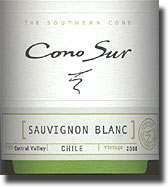 2006
Cono Sur Central Valley Sauvignon Blanc, 13% alc., $10: Medium straw
color, crisp and medium full bodied with very good varietal character,
grapefruit and gooseberry flavors and aromas, with piney undertones and
a little minerality. A solid core of fruit here, with good intensity
that doesn’t go steroidal like some of its relatives from New Zealand
and decent length on the finish; solid QPR (quality-price-ratio).
Fruit sourced from the Santa Elisa Estate
in Chimbarongo/Colchagua (70%) and Quitralmán Estate in Mulchén/Bío-Bío
(30%), vineyards planted in 1998; alluvial, gravelly soil, low in
fertility. Vertical trellis, drip irrigation and integrated vineyard
management including geese and INIA bands for pest control. Harvested
March 12th, handpicked with a yield of 4 tons/acre. Vinification: 100%
destemmed, stainless steel, cold maceration at 46º F, followed by 3
months in stainless steel. Find this wine 2006
Cono Sur Central Valley Sauvignon Blanc, 13% alc., $10: Medium straw
color, crisp and medium full bodied with very good varietal character,
grapefruit and gooseberry flavors and aromas, with piney undertones and
a little minerality. A solid core of fruit here, with good intensity
that doesn’t go steroidal like some of its relatives from New Zealand
and decent length on the finish; solid QPR (quality-price-ratio).
Fruit sourced from the Santa Elisa Estate
in Chimbarongo/Colchagua (70%) and Quitralmán Estate in Mulchén/Bío-Bío
(30%), vineyards planted in 1998; alluvial, gravelly soil, low in
fertility. Vertical trellis, drip irrigation and integrated vineyard
management including geese and INIA bands for pest control. Harvested
March 12th, handpicked with a yield of 4 tons/acre. Vinification: 100%
destemmed, stainless steel, cold maceration at 46º F, followed by 3
months in stainless steel. Find this wine
2006 Cono Sur Casablanca Valley Sauvignon Blanc Visión, 13% alc.,
$14: Pale to medium straw color, with a note of jalapeno over
grapefruit and gooseberry on the nose, and more of the same on the
palate, minus the pepper; crisp, sleek and perhaps a little more
streamlined and a little lighter in weight than the regular model noted
above. It’s a bit more Kiwi-like than the first wine and perhaps that’s
why I don’t like it quite as well, but that’s not to say that it isn’t a
good wine on its own terms. Fruit sourced
from the El Centinela Estate; mineral soil with red clay. Clone Davis
#1, vertical trellis, drip irrigation and integrated vineyard management
including geese and INIA bands for pest control. Harvested April 21st,
handpicked with a yield of 3.24 tons/acre. Vinification: 100% destemmed,
stainless steel, 100% cold maceration with no malolactic, then aged in
stainless steel. Find this wine
2006 Cono Sur Central Valley Chardonnay, 13.5% alc., $10: Medium
straw color, with rich Chardonnay character reminiscent of apple and
pear flavors and aromas laced with a streak of lime, herbaceous
undertones and a touch of minerality; a little stingy on the nose, but
more than enough concentration on the palate to compensate. Medium full
bodied, with excellent cut and good length; another solid QPR.
Fruit sourced from the Santa Elisa Estate
in Colchagua (34%), El Marco Estate in Casablanca (38%) and Quitralman
Estate in Bio-Bio (28%); alluvial, gravely soil, sandy with a bit of
clay, low in fertility. Vertical trellis, drip irrigation and integrated
vineyard management including geese and INIA bands for pest control.
Harvested in Casablanca, March 23rd; Colchagua, March 13th; Bio-Bio,
April 2nd, with yields of 4 tons per acre. Vinification: 52% destemmed,
42% direct pressed. Stainless steel, then aged for 3 months in medium
toast French oak. Find this wine
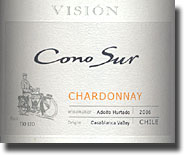 2006
Cono Sur Casablanca Valley Chardonnay Visión, 13% alc., $14: Medium
straw color, with a tight nose of ripe apple-pear; follows through and
expands on the palate with undertones of pine, lime and a certain
herbaceousness; Full bodied, rich and ripe, with good cut and length and
excellent intensity. Well worth the price tag.
Fruit sourced from the El Centinela
Estate; mineral soil with red clay. Vertical trellis, drip irrigation
and integrated vineyard management including geese and INIA bands for
pest control. Harvested April 10th, hand picked, with yields of 2.83
tons per acre. Vinification: 100% direct pressed, no maceration, no
malolactic, then aged in stainless steel, and 40% in new French oak for
7 months. Find this wine 2006
Cono Sur Casablanca Valley Chardonnay Visión, 13% alc., $14: Medium
straw color, with a tight nose of ripe apple-pear; follows through and
expands on the palate with undertones of pine, lime and a certain
herbaceousness; Full bodied, rich and ripe, with good cut and length and
excellent intensity. Well worth the price tag.
Fruit sourced from the El Centinela
Estate; mineral soil with red clay. Vertical trellis, drip irrigation
and integrated vineyard management including geese and INIA bands for
pest control. Harvested April 10th, hand picked, with yields of 2.83
tons per acre. Vinification: 100% direct pressed, no maceration, no
malolactic, then aged in stainless steel, and 40% in new French oak for
7 months. Find this wine
2006 Cono Sur Bio-Bio Valley Riesling, 12.5% alc., $10: Pale
straw color with a tinge of lemon; crisp, correct and refreshingly dry,
with green apple, citrus and mineral in both flavor and aroma. Good
intensity of flavor here and excellent acidity; there’s nothing lazy or
flat about this, and it pairs well on this occasion with sautéed chicken
breast and onions, broccoli and baked potatoes.
Fruit sourced from the Quitralman Estate,
vineyard planted in 1986; mineral soil with red clay. Vertical trellis,
drip irrigation and integrated vineyard management including geese and
INIA bands for pest control. Harvested April 10th, hand picked, with
yields of 4 tons/acre. Vinification: 100% destemmed, stainless steel,
cold maceration at 46º F, no malolactic.
Find this wine
2006 Cono Sur Casablanca Valley Gewurztraminer Visión, 13.5% alc.,
$14: This medium straw sure smells like gewurz, all peachy and
litchi and stuff, but it tastes more like Sauvignon Blanc at first,
according to Cousin Larry Meehan; medium to medium full bodied, tart and
crisp, with under-ripe fruit; however, it opens quickly with only a few
more sips to reveal the floral peach and litchi that are so
characteristic of the varietal and a subtle fruit (not sugar) sweetness,
with good intensity and some mineral underneath. There’s nothing
delicate about this wine, indeed, it’s quite assertive, and the more I
sip, the more I like. Fruit sourced from
the El Marco Estate, planted in 1997; sandy soil with clay and low water
retention. Vertical trellis, drip irrigation and integrated vineyard
management including geese and INIA bands for pest control. Cordon
pruning with 2 bud spurs every 10 cms., 35% leaf removal. Harvested
April 10th, hand picked, with yields of 2.83 tons/acre. Vinification:
100% destemmed, stainless steel, 100% cold maceration; aged in stainless
steel. Find this wine
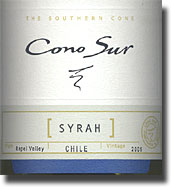 2005
Cono Sur Rapel Valley Syrah, 85% Syrah, 6% Malbec, 4% Carmenere, 3%
Cabernet Sauvignon, 2% Aspiran Bouchet, 14% alc., $10: Ruby dark
garnet color, with kind of a red fruit Santa Claus nose, all cherry,
berry and plum with a hint of chocolate as well; the aromatics don’t
exactly jump out of the glass, but they do give a glimpse of the
considerably more expressive flavors, which echo and expand with plenty
more of everything, plus a toasty note of oak. With moderate tannins,
just enough acidity and decent length, this is ready and easy to drink;
not very complex, just a good everyday $10 Syrah.
Fruit sourced from vineyard(s) with
alluvial soil, poor and stony. Vertical trellis, drip irrigation and
integrated vineyard management including geese and INIA bands for pest
control. Cordon pruning with 2 bud spurs every 10 cms., 35% leaf removal
to enhance phenolic ripeness. Harvested April 20th with yields of 4.45
tons/acre. Vinification: 100% destemmed, stainless steel, cold
maceration for 4 days, with 100% malolactic fermentation; aged for 10
months in medium toast French oak. Find this wine 2005
Cono Sur Rapel Valley Syrah, 85% Syrah, 6% Malbec, 4% Carmenere, 3%
Cabernet Sauvignon, 2% Aspiran Bouchet, 14% alc., $10: Ruby dark
garnet color, with kind of a red fruit Santa Claus nose, all cherry,
berry and plum with a hint of chocolate as well; the aromatics don’t
exactly jump out of the glass, but they do give a glimpse of the
considerably more expressive flavors, which echo and expand with plenty
more of everything, plus a toasty note of oak. With moderate tannins,
just enough acidity and decent length, this is ready and easy to drink;
not very complex, just a good everyday $10 Syrah.
Fruit sourced from vineyard(s) with
alluvial soil, poor and stony. Vertical trellis, drip irrigation and
integrated vineyard management including geese and INIA bands for pest
control. Cordon pruning with 2 bud spurs every 10 cms., 35% leaf removal
to enhance phenolic ripeness. Harvested April 20th with yields of 4.45
tons/acre. Vinification: 100% destemmed, stainless steel, cold
maceration for 4 days, with 100% malolactic fermentation; aged for 10
months in medium toast French oak. Find this wine
2006 Cono Sur Central Valley Pinot Noir, 14% alc., $10: Clean
ruby garnet color and very tight on the nose, gradually opening to give
a little preview of the medium full bodied black cherry and plum flavors
with dark mineral undercurrents; good now, but this has the depth,
tannins and acids to develop for at least a year or two. An hour’s worth
of air helps this out, so some time in a decanter can’t hurt at all; all
in all, a good everyday Pinot Noir. Fruit
sourced from the Santa Elisa Estate in Colchagua (75%), Quitralman
Estate in Bio-Bio (20%) and El Marco Estate in Casablanca (5%), with
alluvial, gravelly soil, low in fertility. Vertical trellis, drip
irrigation and integrated vineyard management including geese and INIA
bands for pest control. Harvested March 21st with yields of 4 tons/acre.
Vinification: 100% destemmed, stainless steel, cold maceration for 4
days at 46º F., with 100% malolactic fermentation; aged for 3 months in
medium toast French oak. Find this wine
2006
Cono Sur Colchagua Valley Pinot Noir Visión,
14% alc., $14: Ruby garnet color with a reticent nose; more generous
on the palate, offering black cherry, plum and hints of coffee and cola,
all underscored with an earthy dark minerality and being a little deeper
and richer, with a little more of everything than the regular model.
Three to five years worth of tannins, with good acids and length; I
would give this some time in the cellar and drink it later rather than
sooner. Fruit sourced from the
Santa Elisa Estate in Colchagua (85%) and El Marco II Estate in
Casablanca (15%); alluvial, gravelly soil with moderate fertility;
planted in 1968. Oregon clone, vertical trellis, drip irrigation and
integrated vineyard management. Harvested March 16th, 100% handpicked
with yields of 2.83 tons/acre. Vinification: 100% destemmed, stainless
steel, 100% cold maceration and malolactic fermentation; aged for 10
months in French oak barrels 80% new and 20% second use.
Find this wine
Neither one of the Pinot Noirs are lightweights, but neither are they
steroidal Syrah wannabes like too many coming out of California these
days; both have substance and depth, and I’d like to try them again in a
few years.
2006 Cono Sur Colchagua Valley Carmenere, 85% Carmenere, 9% Cabernet,
4% Syrah, 2%, Aspiran Bouchet, 13.9% alc., $10: Dark garnet color,
with blackberry and blueberry flavors and aromas that show earthy
undertones and noticeable oak; medium full bodied, fairly smooth, and
reasonably well structured, with decent length. This is a nice enough
everyday red in the international style and will likely improve with a
year or two in the cellar. Fruit sourced
from the Paredes Viejas, Santa Elisa and Puente Alta Estates in
Colchagua; dark clay soil with moderate vigor. Vertical trellis, drip
irrigation and integrated vineyard management including geese and INIA
bands for pest control. Cordon pruning with 2 bud spurs every 10 cms.,
35% leaf removal to enhance phenolic ripeness. Harvested in late April,
100% handpicked with yields of 4 tons/acre. Vinification: 100% destemmed,
stainless steel vessel, cold maceration for 4 days at 39-46º F and 100%
malolactic fermentation; aged for 11 months in medium toast French oak. Find this wine
2005 Cono Sur Colchagua Valley Merlot Visión, 85% Merlot, 7%
Cabernet, 5% Malbec, 2% Syrah, 1% Aspiran Bouchet, 14% alc., $14:
Dark garnet color; charred oak gives notes of balsa, coffee and toast
over black fruit on the nose, with a little vanilla lurking in the
background. The oak dominates even more on the palate, and that’s just
what this tastes like, oak. Black currant and blackberry provide a solid
core of fruit underneath and it’s too bad that it’s overwhelmed by all
the wood. There’s good structure and depth here, but did I mention that
there’s just too much oak?! I can just about finish one glass, but
that’s all. Fruit sourced from the
Paredes Viejas Estate (85%), and other vineyards (15%) in Colchagua ;
dark clay soil with moderate vigor. Vertical trellis, drip irrigation
and integrated vineyard management including geese and INIA bands for
pest control. Harvested April 20th, handpicked with yields of 2.83
tons/acre. Vinification: 100% destemmed, stainless steel, cold
maceration and malolactic fermentation; aged for 10 months in French
oak. Find this wine
OK, so the whites from Cono Sur are all pretty enjoyable, showing good
fruit and balance with no excessive characteristics; the Pinot Noirs are
interesting too, and show good promise for further development, but the
Carmenere and Merlot give some indications that they have yet to get
their Bordeaux varietals right, unless you LIKE all that oak. And while
we’re not wild about these last two, they don’t come close to being as
objectionable as the following abomination.
2005 Cono Sur Central Valley Cabernet Sauvignon, 85% Cabernet
Sauvignon, 9% Merlot, 2% Carmenere, 3% Syrah, 1% Aspiran Bouchet, 14%
alc., $10: Dark garnet color, and that’s the only good thing that
can be said about this one. Kim wondered aloud, “Where’s the Cabernet in
this? It’s hard to tell this is even a grape product.” She has a good
point; it’s all about allspice, with no fruit character of any kind to
be found. I took four or five sips to make sure I was not hallucinating
as to what I was tasting and then dumped the rest of my glass. A truly
horrid wine, and not even worthy of inclusion in the vinegar crock.
Fruit sourced from vineyards planted in
1985; alluvial and gravely soil, low in fertility. Vertical trellis,
drip irrigation and integrated vineyard management including geese and
INIA bands for pest control. Cordon pruning with 2 bud spurs every 10
cms., 35% leaf removal to enhance phenolic ripeness. Harvested April
2nd, with yields of 4 tons/acre. Vinification: 100% destemmed, stainless
steel, cold maceration and 100% malolactic fermentation. The must is
concentrated by bleeding some juice. Aged for 10-12 months in medium
toast French oak. Find this wine
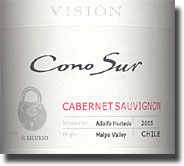 2005
Cono Sur Maipo Valley Cabernet Sauvignon Visión, 85% Cabernet Sauvignon,
5% Syrah, 4% Malbec, 3% Carmenere, 2% Petite Verdot, 1% Aspiran Bouchet,
14% alc., $14: Dark garnet color, with far too much oak for my
liking, but at least it shows fruit characteristics, with a solid core
of deep, dark black currant and cassis bolstered by excellent structure;
still, the wood is overpowering to the point where I seriously doubt
that it will ever integrate with time in the cellar. Maybe someone will
open a bottle for us in four or five years in the interest of scientific
inquiry, because we have better things to spend our money on.
Fruit sourced from El Recurso Estate in
Maipo (85%) and other vineyards in Rapel (15%); alluvial and gravely soil, low
in fertility. Vertical trellis, drip irrigation and integrated vineyard
management including geese and INIA bands for pest control. Harvested
April 23rd, with yields of 2.83 tons/acre. Vinification: 100% destemmed,
stainless steel, 100% cold maceration and malolactic fermentation. Aged
for 12 months in French oak, 60% new, 30% 2nd use, 10% 3rd use; 3 months
in stainless steel. Find this wine 2005
Cono Sur Maipo Valley Cabernet Sauvignon Visión, 85% Cabernet Sauvignon,
5% Syrah, 4% Malbec, 3% Carmenere, 2% Petite Verdot, 1% Aspiran Bouchet,
14% alc., $14: Dark garnet color, with far too much oak for my
liking, but at least it shows fruit characteristics, with a solid core
of deep, dark black currant and cassis bolstered by excellent structure;
still, the wood is overpowering to the point where I seriously doubt
that it will ever integrate with time in the cellar. Maybe someone will
open a bottle for us in four or five years in the interest of scientific
inquiry, because we have better things to spend our money on.
Fruit sourced from El Recurso Estate in
Maipo (85%) and other vineyards in Rapel (15%); alluvial and gravely soil, low
in fertility. Vertical trellis, drip irrigation and integrated vineyard
management including geese and INIA bands for pest control. Harvested
April 23rd, with yields of 2.83 tons/acre. Vinification: 100% destemmed,
stainless steel, 100% cold maceration and malolactic fermentation. Aged
for 12 months in French oak, 60% new, 30% 2nd use, 10% 3rd use; 3 months
in stainless steel. Find this wine
Cono Sur imported by Vineyard Brands, Inc.,
Birmingham, AL
Reporting from Day-twah,
Bastardo

Other Recent Wine Explorations
More Red Wings &
Red Rhônes, 2007
Tasting Two Napa Wineries:
Stag's Leap Wine Cellars & Merryvale Vineyards
Bubbles Galore!
Tasting with Jim Lester
No Shiraz at Shiraz (this time...)
More Drawing of the Threes
Spice Route,
Fairview and Goats Galore
The Drawing of the Threes
Back to the
April 2007 Index
Back to the Underground
Index
Back to the Top


© George Heritier April, 2007
|



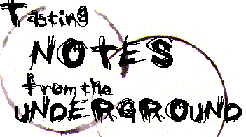

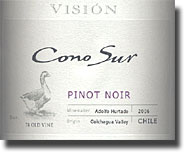



 2005
Cono Sur Maipo Valley Cabernet Sauvignon Visión
2005
Cono Sur Maipo Valley Cabernet Sauvignon Visión